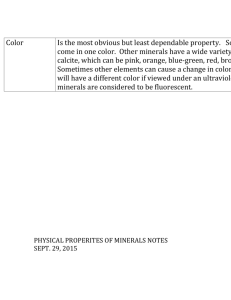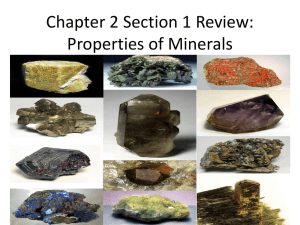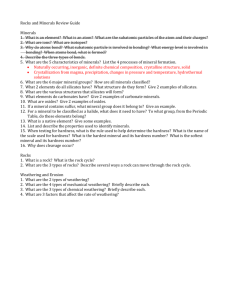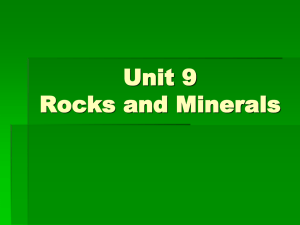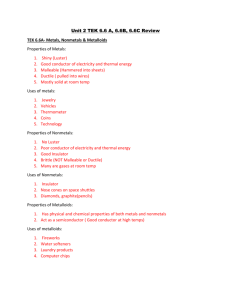Mineral Identification Key - Minerals Education Coalition
advertisement
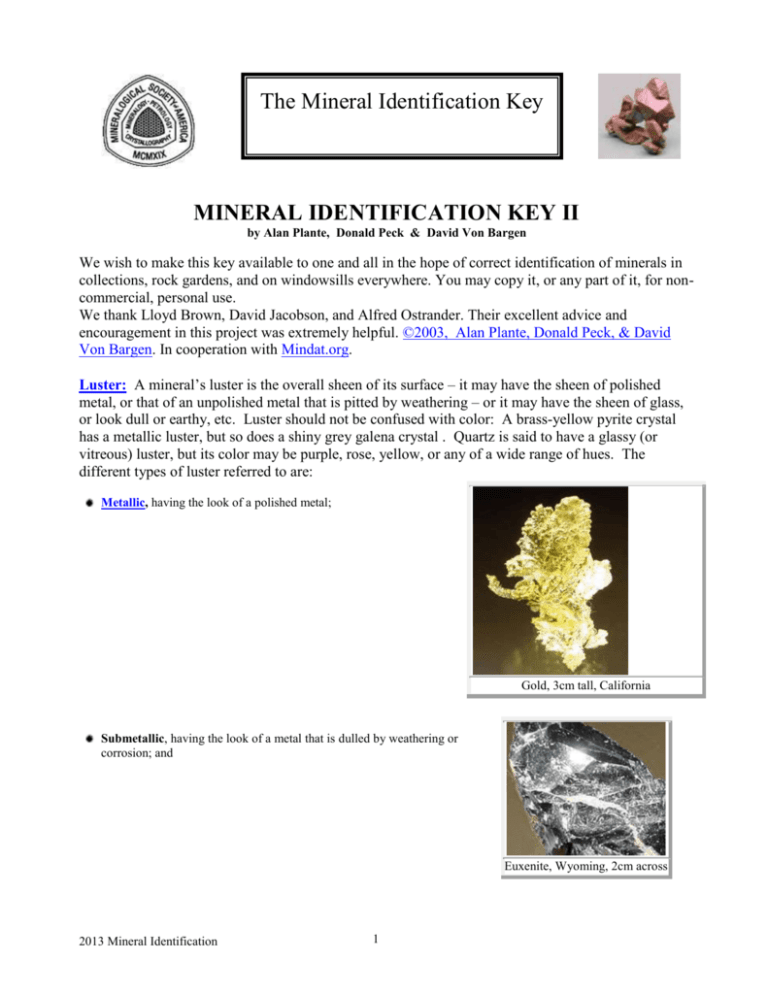
The Mineral Identification Key MINERAL IDENTIFICATION KEY II by Alan Plante, Donald Peck & David Von Bargen We wish to make this key available to one and all in the hope of correct identification of minerals in collections, rock gardens, and on windowsills everywhere. You may copy it, or any part of it, for noncommercial, personal use. We thank Lloyd Brown, David Jacobson, and Alfred Ostrander. Their excellent advice and encouragement in this project was extremely helpful. ©2003, Alan Plante, Donald Peck, & David Von Bargen. In cooperation with Mindat.org. Luster: A mineral’s luster is the overall sheen of its surface – it may have the sheen of polished metal, or that of an unpolished metal that is pitted by weathering – or it may have the sheen of glass, or look dull or earthy, etc. Luster should not be confused with color: A brass-yellow pyrite crystal has a metallic luster, but so does a shiny grey galena crystal . Quartz is said to have a glassy (or vitreous) luster, but its color may be purple, rose, yellow, or any of a wide range of hues. The different types of luster referred to are: Metallic, having the look of a polished metal; Gold, 3cm tall, California Submetallic, having the look of a metal that is dulled by weathering or corrosion; and Euxenite, Wyoming, 2cm across 2013 Mineral Identification 1 Non-metallic, not looking like a metal at all. Nonmetallic luster is divided into several sub-types: Adamantine, having the hard, sparkly look of a diamond; Diamond, Zaire 1 cm. Resinous, having the look of amber – not quite glassy; Sphalerite, 4 cm across, Spain Glassy/Vitreous, having the look of glass; Pollucite 3cm. across Pearly, having the iridescent look of mother-of-pearl (though usually just barely); often found on the cleavage face of a mineral having perfect cleavage Stellerite, Pakistan, 2 cm across 2013 Mineral Identification 2 Greasy/Oily, having the look of an oil-coated substance; Nepheline and cancrinite (yellow) 2cm across, Maine Silky, having the look of silk, fine parallel fibers of mineral – such as chrysotile "asbestos"; Gypsum, variety satin spar, 10cm across Dull, having a plain looking surface that is not submetallic; Anglesite, 2 cm across, Wisconsin Earthy, having the look of soil or clay. Kaolinite after orthoclase, England, 2cm across Certain minerals with a resinous or adamantine luster – such as sphalerite and cinnabar respectively – can appear submetallic. Care needs to be taken in deciding which of these lusters a particular mineral has. Since getting the luster right is the first critical step in keying out a mineral, always do your best to determine what the luster of a "mystery mineral" is before going on to the next step. 2013 Mineral Identification 3 Hardness is a mineralogical term denoting how resistant a mineral is to being scratched. It should not be confused with a mineral’s overall "toughness." (Diamond is the hardest known mineral, but it has a perfect cleavage and breaks easily along that cleavage.) Relative Hardness is used in identification by comparing the hardness of the mineral to that of items with known hardness. Mohs Scale of Relative Hardness is used, and is presented here with the addition of a few common materials of known hardness added: 1: Talc (softest) 6: 6½: 7: 2: Gypsum 8: 9: 2½: Fingernail 9-9½: 3: Calcite or Copper Penny 10: 4: Fluorite 5: Fluorapatite Orthoclase (or Microcline) Steel File Quartz Topaz Corundum Carborundum Diamond (hardest) 5+: Pocket Knife or Nail 5½: Window Glass One tests for Relative Hardness by scratching the surface of a crystal or cleavage face with an item of known hardness – and vice versa, scratching the item of known hardness with a sharp point, edge, or grain of the mineral being tested. Whenever possible, the test should be done both ways – first trying to scratch the sample, then trying to scratch the item of known hardness, such as scratching a crystal face with a knife point and then trying to scratch the knife blade with the point or a sharp edge of the crystal. Since some minerals may leave a powdered streak on the item being scratched (or the known hardness item may leave a streak on the sample) one must rub the "scratch" with a finger to see if it is really a scratch or just a powder streak that rubs off. If a mineral produces a powder streak on the item being scratched then it is probably softer than that item. (Conversely, if the item leaves a streak on the sample it is softer than the sample.) Since the "scratch test" is very important to the identification of minerals every effort should be made to get a positive result – be sure that the correct hardness is determined. With some samples, it may take several tries before one can safely conclude the sample’s hardness. Streak is simply the color of a mineral powder. Many minerals have a different color when powdered than they do in crystal or massive forms. The color may be entirely different, or it may be a different shade. Quite a few minerals give a powder streak that is lighter in color than the whole crystal or massive pieces. A streak is usually obtained by dragging a sharp edge, grain, or point of a crystal across a streak plate – which is simply an unglazed piece of porcelain tile, such as those used in bathrooms and kitchens. (If you get your streak plate from a home improvement shop be sure what you get is unglazed porcelain – not plastic or some other material.) A porcelain streak plate has a relative hardness of about 6½. So minerals of that hardness and greater can not be tested on it – they’ll only scratch it. Some geologists use a steel file to test the streak of minerals with a hardness of 6 to 6½. Streak plates tend to end up covered with traces of mineral powder in various colors. They can be "refreshed" by sanding them with fine emery sandpaper – 220 grit or higher. Do not use a coarser grit, as it will roughen the surface of the streak plate. Some minerals can be difficult to get a good powdered streak from. As with other tests, repetition usually pays off. Always try to use a sharp edge or point, rather than just dragging the mineral across 2013 Mineral Identification 4 the streak plate willy-nilly. While some soft minerals give a streak easily no matter how you drag them, others will not streak well unless you use a small surface area of the mineral to get the streak. Get in the habit of looking for and using a sharp edge, grain, or the point of a crystal. Color is often a double-edged sword in mineral identification: There are many minerals which have distinctive colors; but there are also many which come in a variety of hues. And the same color can be seen in several different species. So one needs to use color as a criteria with care. That "malachitegreen" mineral may not be malachite… That brass-yellow metallic mineral may not be pyrite… It is always a good idea to try and get a powdered streak from any colored mineral and compare it with descriptions of the streaks for the likely suspects you have in mind. It is also always wise to consider the habit of the mineral in conjunction with the color. A green prismatic crystal with a hexagonal cross-section is more likely to be elbaite than malachite. A brassy wedge-shaped crystal is more likely to be chalcopyrite than pyrite. Color, in general, should never be taken as diagnostic by itself. While it may be for certain species, more likely than not it isn’t. Else the job of mineral identification would be made easy. Play of Color can be more helpful than the color itself. Characteristics such as opalescence, iridescence, chatoyancy and asterism are peculiar to a limited number of species, or varieties of species. Opalescence, as the word suggests, refers to an opal-like play of light, reflections off the mineral producing flashes of color that may appear somewhat like a patch-work of different "grains" of color that aren’t really there: Move the sample minutely and the color disappears from that spot. It is sort of like taking a pearly luster to the nth degree. Iridescence Iridescence is the production of a rainbow of colors caused by interference of light in thin films of different refractive indices and varying thickness (the oil sheen on water is an example of this). Minerals with metallic luster, such as bornite and chalcopyrite are good examples of minerals which exhibit iridescence. A couple of cases where it does not involve metallic minerals are the way fracture surfaces in quartz may show it, and the way some fluorite crystals may exhibit it on the surfaces of their faces. Another exception is the type of iridescence known as labradoresence or schiller, found in labradorite and a very few other minerals. Chatoyancy is the play of light off closely packed parallel fibers or parallel inclusions in cavities. The light reflects along lines – which may be straight or curved – giving the mineral a somewhat silky appearance. This characteristic is seen in such minerals as "satin spar" gypsum, "tiger’s eye" (fibrous crocidolite replaced by quartz), and chrysoberyl. Asterism is a type of chatoyancy in which the fibers or inclusions reflecting the light are arranged in a pattern radiating outwards from a point producing a star-like pattern. This is most often seen in rubies and sapphires, and sometimes in phlogopite mica that has rutile inclusions. Luminescence is the emission of light by a mineral other than the reflected light of the sun or a lamp – the mineral "glows" due to some other reason. The usual reason is reaction to ultraviolet light, though X-rays and electrons may produce it as well. The types of luminescence seen in minerals are fluorescence and phosphorescence – two closely related phenomena. Fluorescence results from electrons orbiting the mineral’s atoms being excited by ultraviolet light; the electrons "absorb" the energy and jump to higher orbits, then fall back to their original orbits – giving off light in the visible spectrum as they do. Phosphorescence is basically the same thing, but continues for a time after the source of excitation is removed, giving off energy as visible light more slowly. The fact is that most fluorescent minerals exhibit phosphorescence to some extent, though it usually can only be seen under careful lab conditions. Only a very few minerals phosphoresce well enough to see in a simple darkened room, and the phenomenon is usually rather short lived. Fluorescence is a useful field identification tool for collectors who have UV lights (and a thick blanket when in the field) Many localities have at least a couple of fluorescent minerals, and some – 2013 Mineral Identification 5 like Franklin/Ogdensburg, New Jersey, USA – have a wealth of them. Where they are present, the UV light can be put to use in identifying them. Some animals such as scorpions also will fluoresce so be careful when picking up a fluorescent object in the field. 2013 Mineral Identification 6
